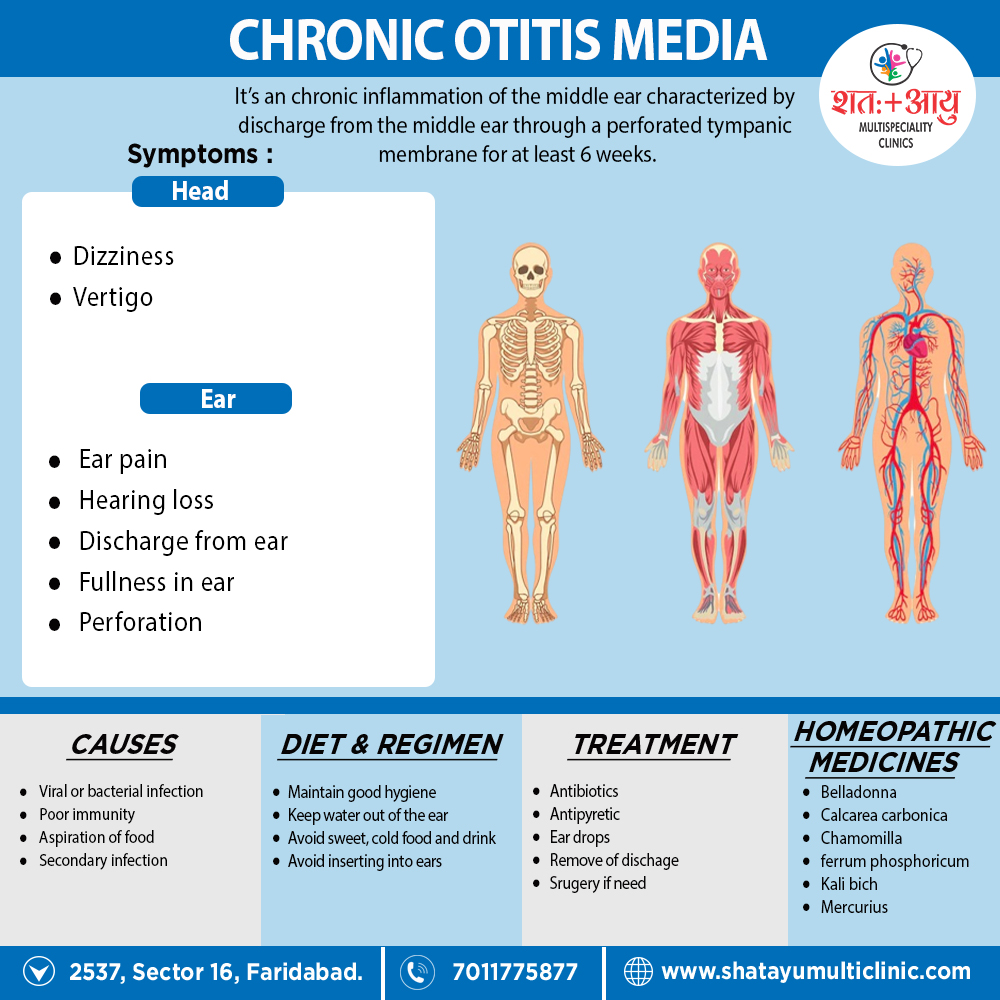Homeopathic Treatment Chronic Otitis Media
Belladonna
This medicine is frequently useful where there is a rapid and violent onset of symptoms that involve mental excitement, anxiety, sensory hyperesthesia, pupil dilation, cold extremities, redness and acute inflammation. The tympanic membrane is often bright red and bulging, there may be a bright, dry, red throat, pounding, throbbing pain in the right ear, dry skin, an aching in the face extending to the neck, a high fever, and a bright red or flushed face. The otitis may be associate with teething and symptoms come and go quickly. The symptoms are usually worse from jarring, from a draught, from light or noise, and are usually better from bed rest and in a warm room.[3]
Chamomilla
The Chamomilla is never please, is restless, angry and irritable, thirsty, hot, experiences night sweats, is impatient, rejects things that are offere, and strikes others. The prescriber may notice that one cheek is red and hot while the other is pale. Like Belladonna, the otitis here often occurs with teething. The otitis pain frequently causes screaming or whining. The symptoms are worse heat and at night, from teething, and better from carring and from perspiration.[3]
Calcarea Carbonica
The presence of offensive muco-purulent otorrhea, night sweats, photophobia, swollen tonsils, enlarged glands and deafness, particularly when teething is occurring at the same time or there’s been a history of delayed dentition, may indicate the need for Calc carb. There may be a desire for cold drinks, eggs, milk and things that are normally indigestible. The sufferer may appear to be obstinate, may perspire easily, particularly about the head and at night and exhibit a sour odour, and may complain of a sensitivity to cold around the ears and neck. The symptoms are worse from cold weather, from drinking milk or washing, and better from lying on the affected side and from dry weather.
Hepar sulph
Generally, Hepar sulph can be very useful for those suffering from chronic otitis with pharyngitis, deafness, perforations or ulceration of the tympanic membrane, and a yellow purulent cheesy offensive effusion, all of which may progress to mastoiditis. Additionally, Often, pain can feel shooting from throat to the ear on swallowing. The sufferer may be irritable and experience cold sweats, hyperesthesia, may be sensitive to touch. Injuries tend to suppurate and there may be a history of bacterial infections. Besides this, Symptoms are often worse from cold air, dry cold wind and touch, and better from heat, damp weather, wrapping up, from rest and in the morning.[3]
Sulphur
This medicine may require to be use as an intercurrent when other well-indicated medicines fail to act. The pointers here include restlessness, aggression, a dislike of bathing, frequent skin eruptions, relapsing complaints, itchy skin, tinnitus, deafness, ailments from milk, and a desire for sweets. The sufferer may experience morning diarrhoea, profuse urination, respiratory congestion, hot sweaty hands, as well as flushes of heat with dry skin. The body generally appears to be unclean. The symptoms here are commonly worse warmth in bed, in the early morning, from washing or bathing, and better during warm dry weather and in the open air.
Capsicum
The symptoms guiding the prescription of Capsicum include a high fever, chills, stinging, stabbing or burning ear pain with suppuration, a hot face, halitosis, red cheeks, pain and dryness in throat, inflamed fauces, uvula and palate, as well as mastoiditis. The body may appear to be unclean. Symptoms are worse from cold, on coughing in the open air and from draughts, and better from heat and eating.
Ferrum Phos
Ferrum Phos is frequently think as being useful in the early stages of all febrile and inflammatory disorders, also as such is useful in the early stages of otitis. Specific indications include inflammation and bulging of the tympanic membrane, lassitude, feverish also yet chilly at around 1pm, tinnitus and flushing of the face. Symptoms are worse on the right side, especially, at night and from 4-6am, from touch or jarring, on the other hand; better from cold applications.[3]
Kali bich
Kali Bichromicum is often think in chronic situations involving a perforation of the ear drum accompanied by a muco-purulent discharge. Involved tissues are irritable, there may be a stringy or globular yellow nasal discharge, a dry mouth and throat, sinus headache and fever. Symptoms are worse on the left side, in the morning and from cold, and are better from heat.[3]
Kali mur
Chronic otitis with mastoid involvement and excessive granulation occurring in the inner third of the auditory canal often respond well to this medicine. Swollen glands, flatulence, deafness, tinnitus and a history of glue ear and tonsillitis may also notify. Symptoms are worse from motion, open air, cold drinks, and are better from rubbing.
Lycopodium
In this instance, symptoms often start on the right side, then either stay there or travel to the left. Other indicators include tinnitus, deafness, thick yellow offensive otorrhea, a desire for sweets and warm food, increased appetite, flatulence, cold extremities, dry skin, intermittent chills and sweats and hyperesthesia to noise. Symptoms are worse in the late afternoon to evening or on waking, from warmth and are better from motion, from cold applications and from uncovering.[3]
Mercurius Solubilis
A severe sore throat, prostration, fever, night sweats, moist skin, thick offensive either yellow or green discharges, profuse sweating, swollen lymph nodes, ear pain also excessive salivation may be indicators for this prescription. The sufferer often experiences tremors in the extremities, is chilly, craves bread also butter and cold drinks. Symptoms are especially; worse at night, from heat, a warm room, a warm bed, also from perspiration.
Tellurium
On examination, one may note a drum head that is dark purple, with elevated spots in the local area that form vesicles. Moreover, Which break and produce a watery acrid excoriating discharge that smells of fish. Symptoms tend to develop slowly and deafness may occur. Aggravation at night, from cold, touch, also lying on affected side. Lastly, Symptoms are better from lying on the back.[3]

